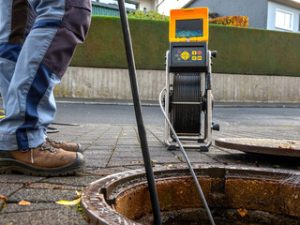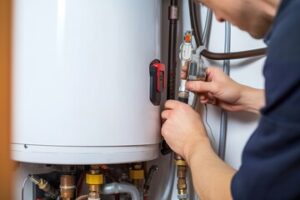Commercial drain pipes can get clogged with fats, greases, soaps, food waste, hair, and other debris. Clogged commercial drains can cause severe plumbing problems and a disruption to your business.

Commercial Sewer Drain Cleaning Services are required to resolve these clogs and restore proper drainage to your business. There are several methods for cleaning commercial drains, including power snaking, video inspection, hydro jetting, and chemical unclogging agents.
Drain clogs can be annoying at best, and if left unattended can lead to serious plumbing problems at worst. Instead of calling a plumber for expensive drain repairs, homeowners can take care of clogs themselves with the help of a drain snake, a time-tested tool that eliminates clogs and prevents future ones. While it may seem intimidating to use a drain snake, by following a few simple steps, it is easy enough for any homeowner to do at home.
A drain snake, also known as a plumber’s auger or “plumbing snake,” is a long, flexible metal cable with a handle on one end and a corkscrew-like blade on the other. It is designed to navigate the twists and turns of pipes, hooking and breaking up clumps of hair, congealed grease, food waste, gunk, stuck objects, and other debris that accumulate in drains and sewer lines. When a drain snake is used properly, it can remove clogs that would be impossible to clear using chemical drain cleaners, which can damage pipes and emit toxic fumes.
Before you try to use a drain snake, make sure to prepare the area by putting down towels or a bucket to catch any water or debris that might spill. It is also recommended to wear rubber gloves and safety goggles, as the process can be messy. Lastly, it is important to read the instructions specific to your model of drain snake, so you can be aware of any special instructions or precautions that might apply.
Once you’re ready to begin, insert the snake into the clogged drain slowly and feed it until you feel resistance or hear a “give.” When you encounter this, turn the handle to break up or dislodge the clog. If necessary, rotate the snake while feeding it to navigate bends and dislodge more stubborn obstructions. If the clog remains, it might be time to resort to a power-feed snake or a different cleaning method.
While a drain snake can be effective for many types of clogs, there are certain types of blockages that it is not appropriate for. For example, it is not a good idea to use a drain snake on a kitchen sink drain that is clogged with grease because the fat can harden and block the pipe. To avoid clogging your drains with grease, dispose of it in the trash rather than pouring it down the drain. Similarly, regular maintenance with drain covers or strainers can help keep hair and other smaller particles from getting caught in the pipe.
Video Inspection
Performing a video inspection is an excellent way to get an idea of the condition of your plumbing system. A qualified plumber can use a specialized camera to view the interior of pipes and to find damage or problems that may be hard to identify from the outside. This allows him to perform a more accurate and efficient job.
In addition, a video inspection is less disruptive than traditional methods of checking for issues in your sewer pipe line. Plumbers no longer need to dig up large portions of your yard or cut into walls to access the pipes and can instead use existing access points, such as clean-outs and drains. This saves you time and money and helps your plumber work faster.
A video inspection also makes it easier to locate the source of a clog. This is especially important if your pipes are a bit older and have been damaged by previous attempts at removing clogs. Hydro jetting can cause further damage to these old pipes by leaving residue behind, and sometimes clogs simply form at the point of entry into the pipe.
If your plumbing company uses a video inspection for your sewer line, the plumber will be able to see the location of the clog or other problem and can then decide on an effective solution. This can help you to save money on costly repairs that could have been avoided if the issue was caught early.
Using a video inspection can also make it easier to identify the type of material your pipes are made of, which will help determine whether hydro jetting or other pipe-clearing techniques will be effective. Some clogs are caused by materials that can’t be removed with conventional methods, such as dense roots or crushed clay pipes.
A video inspection can also be helpful for identifying other plumbing issues. This can include leaks in your main plumbing line, broken or cracked pipes and joints, and even the presence of insects or animals nesting inside your pipes. These issues can be a huge headache to deal with, but they are easier to fix and less expensive when identified early.
Hydro Jetting
Hydro jetting is a highly effective way to clean drain lines. It uses water hoses with specialized nozzles to blast highly pressurized jets of spinning water sourced from a storage tank into the pipes, breaking apart and washing away solidified or clogged debris. This is a more versatile and efficient approach to cleaning than simply using a metal snake, especially when dealing with grease-based clogs.
When used on a regular basis, this powerful method of drain and sewer line cleaning can help to prevent future clogs and keep your plumbing system in top condition. It also offers an environmentally conscious solution that can be a safe alternative to chemical drain cleaners.
While it is more expensive than some other drain cleaning methods, the initial investment can help to save money in the long run by reducing costly repairs and downtime. It can even provide an attractive return on investment through improved plumbing efficiency and a reduction in waste buildup.
Sewer jetting is ideal for cleaning drains, septic systems, and sewer lines in commercial properties. Its versatility allows it to be used on a range of pipe materials, including PVC, copper, steel, and cast iron. It is particularly well suited for use on older pipes, as it can be used at a lower pressure than other drain cleaning methods without damaging them.
When compared to traditional drain snakes and chemical cleaners, it is much more effective at dislodging blockages. This is because it cuts through the clog rather than simply pulling it out, making it ideal for more stubborn and deep-rooted clogs. The high water pressures can also break up and flush away tree roots, which can otherwise cause recurrent sewer line blockages.
The power of the water jets can also effectively clean inside the walls of the pipes, which is not possible with other methods. This thorough cleaning can dramatically reduce the chances of future clogs and improve the lifespan of your pipes.
However, it is important to note that hydro jetting may not be able to clear certain severe obstructions or damage. As a result, it is essential to have an experienced plumber evaluate your pipes before proceeding with this method.
Chemical Unclogging Agents
When a drain becomes completely or partially clogged, it can be tempting to use store-bought chemical drain cleaners. These products offer a quick and seemingly easy solution to stubborn blockages, but they are often harsh on pipes and can cause long-term damage. In addition, these cleaners are highly dangerous if not used properly. Many of them require the use of full personal protective equipment (PPE), including thick gloves, safety goggles, and a face mask. They also emit harmful fumes that can irritate the throat, nose, eyes, and skin. Furthermore, they can leave behind chemical stains and residues on sinks, toilets, tubs, and other surfaces.
The main ingredient in many chemical drain cleaners is sulfuric acid, which can cause severe chemical and thermal burns if it comes into contact with your skin or eyes. It can also react with water and certain metals to produce hydrogen gas, which can irritate your lungs and throat. Additionally, most of these cleaners are caustic and can erode pipes, leading to expensive repairs down the line.
While liquid drain cleaners may work on some clogs, they are generally not safe for use with garbage disposals or in homes with old or galvanized pipes. They may also corrode or discolor pipes, leaving behind unpleasant odors and stains. Furthermore, they can be toxic to pets and children if ingested.
If you’re looking for a safer and more environmentally friendly option, there are many different natural drain cleaners available on the market. One popular option is a baking soda-and-vinegar mixture, which creates a chemical reaction to break down the organic buildup that causes a clog. This method can take longer than chemical cleaners, but it’s effective on most clogs and won’t harm your pipes or the environment.
When using any type of drain cleaner, it’s important to follow all product instructions carefully. This includes using the correct dosage and allowing specified sitting times. It’s also important not to mix different types of cleaners, as this can cause dangerous chemical reactions that can release hazardous gases or excessive heat. Finally, working in a well-ventilated area helps avoid inhaling fumes and ensures your safety.
